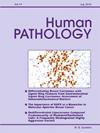Claudin18.2和MUC6在宫颈内胃型腺体病变鉴别诊断中的敏感性和特异性
IF 2.6
2区 医学
Q2 PATHOLOGY
引用次数: 0
摘要
宫颈内胃型腺癌(GAS)当分化良好或粘液较少时可能导致误诊,特别是在活检标本中。本研究旨在评价Claudin18.2和MUC6在诊断GAS及其前驱病变中的敏感性和特异性。选取复旦大学妇产医院病理科167例患者,其中普通型宫颈腺癌(UEA) 43例,GAS 43例,小叶型宫颈腺增生(LEGH) 20例,非典型LEGH (ALEGH) 21例,正常/良性40例。所有病例均行Claudin18.2、MUC6、P53和P16免疫组化染色(IHC)。5%的肿瘤细胞中IHC表达Claudin18.2和MUC6阳性。IHC综合评分的计算方法是将各个程度的评分乘以强度。P53被认为是阳性/突变,在≥75%的细胞中存在强烈的核反应性(过表达),完全阴性(零表达),或显示细胞质染色。弥漫块状染色认为P16阳性。cludin18.2在所有LEGH、ALEGH病例和83.7% (36/43)GAS病例中均为阳性,在所有UEA和良性病例中均为阴性。MUC6在所有LEGH和ALEGH病例中呈阳性,GAS病例为88.4%(38/43),良性病例为40.0% (16/40),UEA病例为20.9%(9/43)。62.8%(27/43)的GAS病例中P53突变表达,其中P16弥漫染色10例,P16完全阴性10例。ALEGH/LEGH组的Claudin18.2和MUC6综合评分均高于GAS组。Claudin 18.2是宫颈胃型腺体病变的敏感特异性标志物,在正常宫颈组织中不表达,但在所有LEGH/ALEGH病例中均表达。但对鉴别GAS和ALEGH没有帮助。MUC6是LEGH和GAS的高敏感标记物,但其特异性远低于Claudin18.2。以形态学为基础,结合P16、P53、Claudin18.2、MUC6等免疫标志物,可显著提高胃型腺体病变的诊断效率。本文章由计算机程序翻译,如有差异,请以英文原文为准。
The sensitivity and specificity of Claudin18.2 and MUC6 in the differential diagnosis of endocervical gastric-type glandular lesions
Endocervical gastric-type adenocarcinoma (GAS) when well-differentiated or with less mucin may lead to misdiagnosis, particularly in biopsy specimens. This study aimed to evaluate the sensitivity and specificity of Claudin18.2 and MUC6 in the diagnosis of GAS and its precursor lesions. 167 cases from the Department of Pathology, Obstetrics and Gynecology Hospital of Fudan University (OGHFU) were selected, including 43 cases of usual type endocervical adenocarcinoma (UEA), 43 cases of GAS, 20 lobular endocervical glandular hyperplasia (LEGH) cases, 21 atypical LEGH (ALEGH) cases, and 40 normal/benign cases. A panel of immunohistochemical stains (IHC) for Claudin18.2, MUC6, P53, and P16 were performed on all cases. IHC expression in >5 % tumor cells was considered positive for Claudin18.2 and MUC6. An IHC composite score was calculated by multiplying the individual scores of extents by intensity. P53 was considered positive/mutant with the presence of strong nuclear reactivity in ≥75 % of cells (overexpression), was completely negative (null expression), or showed cytoplasmic staining. P16 was considered positive if diffuse block-type staining. Claudin18.2 was positive in all cases of LEGH and ALEGH and 83.7 % (36/43) GAS cases but was negative in all UEA and benign cases. MUC6 was positive in all LEGH and ALEGH cases, 88.4 % (38/43) of GAS cases, as well as 40.0 % (16/40) of benign and 20.9 % (9/43) of UEA cases. P53 mutant expression was found in 62.8 % (27/43) of GAS cases, 10 of which showed P16 diffuse staining and 10 of which were completely negative for P16. The composite scores of both Claudin18.2 and MUC6 were higher in ALEGH/LEGH than in GAS. Claudin 18.2 is a sensitive and specific marker for cervical gastric-type glandular lesions, not expressed in normal cervical tissues but expressed in all of the LEGH/ALEGH cases. However, it was not helpful in differentiating GAS from ALEGH. MUC6 is a highly sensitive marker for LEGH and GAS, yet its specificity is much lower than that of Claudin18.2. Taking morphology as the cornerstone and combining immunomarkers such as P16, P53, Claudin18.2 and MUC6 can significantly enhance the diagnostic efficiency of gastric-type glandular lesions.
求助全文
通过发布文献求助,成功后即可免费获取论文全文。
去求助
来源期刊

Human pathology
医学-病理学
CiteScore
5.30
自引率
6.10%
发文量
206
审稿时长
21 days
期刊介绍:
Human Pathology is designed to bring information of clinicopathologic significance to human disease to the laboratory and clinical physician. It presents information drawn from morphologic and clinical laboratory studies with direct relevance to the understanding of human diseases. Papers published concern morphologic and clinicopathologic observations, reviews of diseases, analyses of problems in pathology, significant collections of case material and advances in concepts or techniques of value in the analysis and diagnosis of disease. Theoretical and experimental pathology and molecular biology pertinent to human disease are included. This critical journal is well illustrated with exceptional reproductions of photomicrographs and microscopic anatomy.
 求助内容:
求助内容: 应助结果提醒方式:
应助结果提醒方式:


